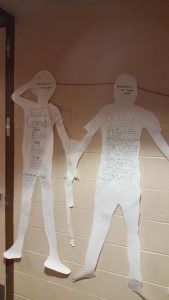Why Interdisciplinary Units Are So Powerful

Examples of students’ character cutouts
I have a love/hate relationship with this time of year.
We’re in full swing with the end-of-year craziness. Yet this also is the time when I teach the American Revolution in social studies. I’m able to combine the content with our historical fiction unit in reading, and our opinion unit in writing. This is a wonderful opportunity to combine content areas and provide a truly immersive experience for my students.
It is so nice to have a seamless day of reading both fiction and nonfiction texts around this topic, and having conversations that span reading, writing, and social studies. I find that I am excited about teaching, and students are excited about learning. It’s no small feat at this time of year!
What The Unit Looks Like
Right now in the hallway are cutouts of characters from our read aloud and our book club books. Within the cutouts are character traits and reflections about critical choices, power, and how these characters were shaped by the times in which they lived. Connecting all of the characters is a red string, and tomorrow students are going to spend time reading the cutouts and making connections. Then we will write them on paper that will hang from the string, making our thinking visible. This is a new project but one whose outcome I am super excited to see.
Another project that I always do during this time of year is a thinking routine from Ron Ritchhart called a “step inside.” This writing project combines the best parts of narrative writing, yet allows students to use their imagination to step inside the life of a slave from the 1500s. As students examine the three phases of slavery as outlined in our text, they attempt to step inside and develop empathy for the experience of these people. This is a lengthy writing assignment and yet one that is incredibly powerful. I have had students tell me it is their favorite writing assignment of the year.
I find that students actually are able to bring more elements of narrative writing in this assignment than they sometimes are able to do in their own pieces. I think this is because of the scaffolding required for the assignment. Also, the assignment requires that they pay attention to a number of details, which enables them expand their normal writing habits.
Integrating Opinion Writing
The opinion writing comes very late in May and in early June. This is when students have to take a side in the American Revolution. They are assigned either the Patriot side or the Loyalist side, and they have to defend their side based on evidence from their historical-fiction text. They also rely on the supplemental reading we do with nonfiction texts.
The opinion pieces have to include a counter argument acknowledging the position of the other side. Yet they also have to defend their own positions and attempt to persuade the reader to agree with them. All of this is used in a real-life debate with a student moderator, and the kids absolutely love it!
As I write this we are at the end of an unusually warm (86 degrees!) day in May. I have a huge to-do list and yet I am still excited about all that is going on in my classroom. All of this gets me wondering how I can channel this same type of integration and excitement into the rest of my year. Perhaps this will become my summer project: examining my curriculum to find better connections and texts that will lend themselves to this cross-curricular type of integration. My wheels are already spinning.
 Beth Rogers is a fifth grade teacher for Clarkston Community Schools, where she has been teaching full time since 2006. She is blessed to teach Language Arts and Social Studies for her class and her teaching partner’s class, while her partner teaches all of their math and science. This enables them to focus on their passions and do the best they can for kids. Beth was chosen as Teacher of the Year for 2013-2014 in her district. She earned a B.S. in Education at Kent State University and a Master’s in Educational Technology at Michigan State University.
Beth Rogers is a fifth grade teacher for Clarkston Community Schools, where she has been teaching full time since 2006. She is blessed to teach Language Arts and Social Studies for her class and her teaching partner’s class, while her partner teaches all of their math and science. This enables them to focus on their passions and do the best they can for kids. Beth was chosen as Teacher of the Year for 2013-2014 in her district. She earned a B.S. in Education at Kent State University and a Master’s in Educational Technology at Michigan State University.
